Boy
Scout Bands
Boy Scout bands were very popular
in the first thirty years of Scouting. Scouts in full uniform, marching
and playing their instruments, were a stirring sight to see and hear, even
if they were not always in tune!
A Band in San Angelo
The San Angelo Kiwanis Club
on May 30, 1922, suggested to a newly appointed Scout committee that a
Boy Scout Band be organized. The committee met that evening and appointed
R. H. Compton and F. L. Traenkle to further investigate the matter.
They noted that a director
would be needed who would have to be paid and someone would have to provide
the money because the Council had no money at all. The Kiwanis Club
agreed to sponsor the band and provide the money.
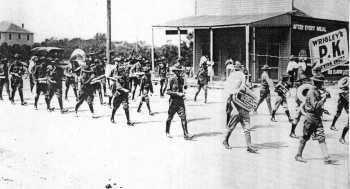 During
summer camp at Camp Vista Concho in late August, the proposition of having
a band was submitted to the boys in camp and a large number of boys signified
their desire to enlist as musicians. Mr. G. A. Hartman, who was director
of the San Angelo Concert Band at the time, was hired to direct the band
and the first meeting of the Scouts was held at the American Legion Opera
House in San Angelo on Tuesday Evening, September 5, 1922, to organize
the group. During
summer camp at Camp Vista Concho in late August, the proposition of having
a band was submitted to the boys in camp and a large number of boys signified
their desire to enlist as musicians. Mr. G. A. Hartman, who was director
of the San Angelo Concert Band at the time, was hired to direct the band
and the first meeting of the Scouts was held at the American Legion Opera
House in San Angelo on Tuesday Evening, September 5, 1922, to organize
the group.
At that meeting, twenty-two
youths signified interest in joining the band. Only about four of
the Scouts had any musical training. Mr. Hartman had previous experience
in directing the Bronte Band and within seven months he had that group
playing overtures and other "heavy" numbers, so he thought this group could
make its first appearance after several months of instruction. By
October 24, 1922, twenty-five boys were practicing regularly, fifteen of
whom were classed as good musicians. The band then consisted of the
following:
Clarinets - Forster Rust,
Ralph Hickman
Saxophones - Celley Birt,
Joel Brown
Cornets - Army Rust, Wilbur
Yancy, Arthur Belling, Vaughn Wood, Cecil Elliot, Wyley Shrum
Altos - Raymond Harris,
Jack Jones, Clarence Alberts
Trombones - Erwin Lyon,
Earl Stovall, Lee Jones, Harold Cornelison, Lyn Bennett, Berton Houston
Baritone - Albert Hartman
Basses - Herbert Hartman,
J. P. Jett, Reece Albert
Base Drum - James Freeman
Snare Drums - B. Abernathy,
Bert Week
The first public appearance
of the band was made during the Kiwanis Club's Ladies' night on November
17, 1922. The thirty boys, now in the band, played several pieces
in the lobby of the St. Angelus hotel prior to dinner and one piece following
dinner. Thirty-six boys were active in the band by December 1, 1922,
when they made their first public appearance on the streets of San Angelo.
They marched up Concho Ave. to the Landon, thence north on Chadbourne to
Beauregard and west to the St. Angelus Hotel and returned by the same route.
They stopped at four of the principal corners of the business district
and played "Our Beginners March," a waltz "Soft Music is Stealing," and
overtures "Nicturo", "Our Leader," and "America."
The Boy Scout Band provided
the music at a Scout Week program held at the First Baptist Church in 1923.
There were 130 boys in Scouting in San Angelo at the time with many of
them in the band. By March 14, 1923, the band was at full strength
with fifty members. By now the draggy playing, jerky time and weakness
in solo and section parts were disappearing from the band. They could
play about fifteen selections including such marches as "Under Arms", "National
Guard" and "Our Leader" as well as a serenade "Stilly Night."
During the summer of 1923,
starting on Thursday evening, June 21, 1923, 8 o'clock, the band played
concerts on the Court House lawn. The band spent two days in Sonora
the first part of July furnishing music for Sonora's four-day Fourth of
July celebration. Forty-two youth made the trip with Hartman.
Mayor W. E. Caldwell of Sonora said "Especially did we appreciate the San
Angelo Boy Scout Band. It rendered excellent music which was enjoyed
by everyone and contributed largely towards creating a spirit in keeping
with the event."
This was the last time we
found a story about the band in THE SAN ANGELO DAILY STANDARD. We
do know, from talking with former band members, that most of the boys later
helped organize the DeMolay Band and played for may Scout activities in
the late '20s and early '30s.
Boy
Scout Band at Ozona
Several publications published
over the years on the history of Ozona made mention of a Boy Scout Band
in Ozona in 1926 and 1927. A story in the Crockett County Golden
Anniversary Historical Edition of 1941 stated "The first band in Ozona
was organized by Mrs. "Red" Smith in November 1926. It was organized
as a Boy Scout Band comprising school students and made it first public
appearance in the town park on July 4, 1927, during the rodeo. The
band was sponsored by the P.T.A. as a school band in 1927-1928.
"Members were Eugene Montgomery,
P. C. Coats, Peas Childress, Tot Grimer, Clifton Monteith, Bill Friend,
Slick Miller, Bert Kincaid, Jr., Batts Friend, John Kirkpatrick, Billy
Baggett, James Baggett, Cam Longley, Billy Childress, Marvin Graves, B.
B. Ingham, Bud Coates, Woodrow Wilson, Massie Ray Smith, Joe Billy Keaton,
Miller Robinson, Lee Dudley and Roger Dudley."
We do not know how many of
these band members were Scouts but we suspect most of them were being as
it was a Boy Scout Band. Apparently the band only lasted a year as
a Boy Scout Band.
The
famous Iraan Cowboy Band
A Boy Scout band was organized
in Iraan, Texas in the May of 1934, under the leadership of E. O. Moore,
who served as Scoutmaster of Troop 49. Charles Baldwin, who played
trumpet, directed the band and Mack Greenhow, saxophonist, was the announcer.
Vern Brownlee served as second Scoutmaster
The band came to Camp Louis
Farr on June 10, 1934, as a Troop. While they were at camp they made
appearances before the Lions Club in Mertzon, over radio station KGLL,
and marched on the streets of Mertzon. First members of this
band were:
Trumpets -- Wilson
Lauderdale, Lewis Blackburn, Orville Fraker, Arthur Barasso, David Morrison,
R. C. Calk
Clarinets -- Udel Copeland,
Layton Johnson, Ed Earl Heberson, and Jack Baker
Saxophone -- Mack Greenhow,
Atlas Charles
Bass Drum -- Robert Ivy
Trap Drums -- Harry Glendenning,
Norman Montgomery
Bass Horns -- Robert Patterson,
Charles Halcomb
French Horns -- Jimmie Rigsbee,
Ted Simon
Altos -- Raymond Warner,
James Cooney, Billy Joe Greenhow
Trombones -- Claude Webb,
Pat Moore
The band was selected as the
official band for the 16th district of the American Legion, and made a
trip to Marfa to participate in their convention from November 16-18, 1934.
Jacques Nonce, high school band instructor, was in charge of the band during
this trip. The citizens of Marfa made arrangements to entertain the
members of the band, and their trip was paid for by the American Legion.
On January 26, 1935, the
band played for the Council's Annual meeting held in San Angelo.
A photo of the band in their Boy Scout uniforms appeared in the January
26, 1935, issue of the SAN ANGELO MORNING TIMES.
The band was suppose to have
gone to the National Boy Scout Jamboree in August of 1935, but because
of a polio epidemic, the trip was canceled and they went to California
to the San Diego Exposition instead.
The band was present at Camp
Louis Farr on June 16, 1937, for the dedication of Carr Village.
They played the Star Spangled Banner, following the invocation, while the
flag was raised in the center of the Village. They also provided
music to the group.
Band
a hit at 1937 National Boy Scout Jamboree
(Taken
from the West Texas Scout News, Tuesday, August 3, 1937, written
by Bryan Cooney)
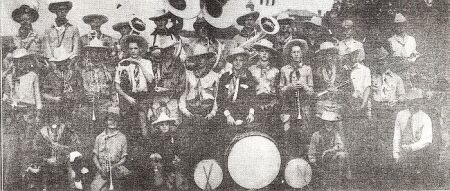
"There were twenty-four Scours
from Troop 49, Iraan, who attended the Jamboree. The rest of the
band of thirty pieces was compost of Scouts from other troops. Under
the capable leadership of Mr. Jacques Nonce, this band put Iraan on the
map. It also gave the Easterners a good idea what Texas is like,
with members wearing cowboy boots, chaps, spurs, gay colored shirts and
ten gallon hats. Others who were with the band were Acting Scoutmaster
H. B. Blackburn, Assistant Scoutmaster James K. Biggs and Assistant Scoutmaster
J. B. Morris.
"This was the official band
for Regions eight and nine, and they had the privilege of greeting Dan
Beard as he arrived at the Jamboree. They serenaded James E. West,
Chief Scout Executive, and broadcast from a National hookup on the Jamboree
grounds.
"Their toughest job at the
Jamboree was playing for the Circus program of region eight and nine.
They had to play fast circus marches for over two hours and then walk three
miles back to camp.
"The boys had a great time.
They visited the Washing Monument, The Capitol, White House, Supreme Court,
Mt. Vernon, Smithsonian Institute, Library of Congress, Arlington Cemetery,
Lincoln Memorial and all the Government Department Buildings.
"The band members were: Luther
B. Stover, Eudell Copeland, Ed Earl Hebisen, Winston Holcomb, Oliver Barnes,
J. B. Copeland, Lewis Blackburn, Keith Anderson, David Morrison, Jolly
Johnson, Montgomery, Zack McFarland, J. D. Carr, Jimmis Rigbee, Elmer Sutton,
Raymond Warner, Bryan Cooney, Leon Harris of McCamey, Tom Hogan from Crane,
Clarence Holcombe, Robert Patterson, Robert Ivy, Norman Montgomery and
Edwin Shadle. Four Scouts from San Angelo also played with the band.
R. C. Calk and Jack Baggett of Ozona were the drum majors."
Make
Trip to Eagle Pass
The band played for the first
Winter Garden Boy Scout Circus in Eagle Pass on November 13, 1937.
They played during the parade of all Scouts present and also several numbers
during the Circus. The band played at the dedication ceremony held
on the Town Square in Iraan on August 23, 1940, for the Sea Scout Patrol's
cruiser, the S.S.S. Yates, prior to the boat being taken to Lake Nasworthy
near San Angelo.
Troop
9's Band
Troop 9, San Angelo, was organized
in January 1935, as a nucleus of a Boy Scout Band for the community.
The band made its first public appearance on Sunday, February 10, 1935,
at the Business Men's Bible Class. At that time the band had eighteen
members. The Scoutmaster of the Troop was Ira Johnson, with Chief
N. N. Bourland as director of the band. The troop was sponsored by
the Community Concert Association.
A year later, the troop gathered
together some forty Scouts, parents, and leaders in the studio of Chief
N. N. Bourland for the first birthday party of the troop. Scouts
Jones Webb, Perry Elliott, Horace Arnold and George and C. J. Poulter gave
musical numbers. We believe the band lasted only a couple of years
because the Boy Scout Band was reorganized in San Angelo in mid October,
1938. This band made its first public appearance at the Council's
Annual meeting held January 20, 1939, on the roof of the St. Angelus Hotel.
The director of the new band, Homer A. Anderson, was band instructor in
the Junior and Senior High schools. Frank Herrington, a junior in
Senior High school, served as assistant band director.
The band did not rehearse
regularly as a Scout unit but was made available for all Scout events at
which music was desired. Scouts in the band were from Troop 2, 4,
6, 7, 11, 12, and 32.
Lone
Scout Band - Rising Star
The following
story appeared in the local newspaper, name unknown, concerning the Lone
Scout Band, around 1927.
"Local
radio fans and friends of the boys will no doubt be interested in learning
that the "Tejas Ticklers" string orchestra of the local Lone Scouts , will
broadcast a program beginning at 10:30 next Tuesday night over Station
K.F.Q. R., the occasion being the opening of he new Wesrook Hotel.
"The
engagement was secured by Melvin Boatman, member of the orchestra who was
in Fort Worth the past week.
"The
boys have only been organized some six months but by constant practice
have developed to the point where they render some very splendid music,
having played at several school entertainments the past fall and at social
gatherings in the city.
"The
boys would be glad for their friends to tune in on the program and no doubt
would appreciate congratulatory messages which would be good publicity
for Rising Star."
A follow-up
story then appeared in the paper:
"Rising
Star received quite a bit of publicity Tuesday night when the "Tejas Tickler"
local Lone Scout Orchestra, gave a program over Station KFQB at Fort Worth,
the boys receiving congratulatory messages from all over the state and
adjoining states. A number of their friends from Rising Star wired
and phone in to express their appreciation of the program, including the
Rising Star Chamber of Commerce.
"The
boys were given a faltering introduction by the announcer, calling each
boy by name and saying some nice things about Rising Star. The boys
got their program over in great shape, the numbers being of the popular
type and also including a number of old time pieces.
"Following
is the personnel of the orchestra:
Claude
Foster, director; guitar.
Harry
Wigginton, leader; violin.
James
Tomlinson, piano.
Merlvin
Boatman, guitar.
Walter
Tomlinson, banjo-uke."
Another
story also appeared about the band in the newspaper in the summer of 1927:
"A
concert by the Tejas Ticklers, Lone Scout string band of this city, will
be one of the principal features at the First Annual Nine Rally and Conference
of the organization to be held at Dallas, August 27-28 (1927). The
young musicians have attracted much attention in scouting circles recently
because of their ability.
"Roy
W. McDonald, National Chief of the Lone Scouts, will deliver the principal
address at the gathering. Mr. McDonald s an expert on all phases
of boys' work and addressed a National gathering of officials of the Boy
Scouts of America, of which the Lone Scouts is a division, at Hot Springs,
Ark., last summer on Lone Scout procedure.
Karl
M. Read, Regional Chief, will speak on the present status of Lone Scout
work in the three states of his jurisdiction: Texas, Oklahoma, New Mexico.
Other addresses by prominent scouts will be made also and plenty of athletic
and scouting contests."
Scout
Orchestra of Breckenridge
According
to the Brownwood Bulletin, January 25, 1936, the music for their Annual
Council Banquet was furnished by the Scout Orchestra of Breckenridge, of
wich J. C. Burkett was director.
Band
at Camp Martin
A. J. Campbell, band director
at Eastland, led the first band at Camp Martin. It was composed of
Scouts from Cisco, Eastland, Olden, Ranger and Gorman who came to camp
from Eastland County Council. It was active at camp in July
1928. Eighteen Scouts were members of the band. The band was
a regular feature of the camp again in 1929.
Other
Bands at Camps
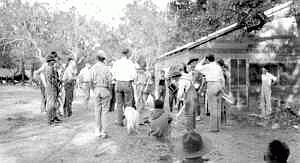 Troops
17 and 18 of Breckenridge arrived at Camp Billy Gibbons in 1932 with a
“well organized band” according to a story in The Bugle Call, the camp
newspaper. The band played “Onward Christian Soldier” while three
Eagle Scouts carried a floral wreath and placed it on rocks gathered by
Scout Troops to use in building a memorial to Billy Gibbons on Sunday,
July 24, 1932. Troops
17 and 18 of Breckenridge arrived at Camp Billy Gibbons in 1932 with a
“well organized band” according to a story in The Bugle Call, the camp
newspaper. The band played “Onward Christian Soldier” while three
Eagle Scouts carried a floral wreath and placed it on rocks gathered by
Scout Troops to use in building a memorial to Billy Gibbons on Sunday,
July 24, 1932.
A Scout orchestra was organized
in Rising Star Troop 15 in January of 1933 under the leadership of the
Assistant Scoutmaster Benny Busbee. Eleven members of the Troop were
part of the orchestra and they were all accomplished musicians. They
were all older Scouts in the Troop, probably high school age who were members
of the high school band. Their first appearance was to be at the
Annual Father and Son Banquet in February.
During the Council Annual
Meetings in January of 1935, 1937, and 1939, music was furnished by the
Breckenridge Scout orchestra that was directed by J. C. Burkett.
The evening program was opened in 1939 with music by the band of Sea Scout
Ship Texan.
Cookie’s
Cookies
Troop 2 organized a Boy Scout
band in early 1939 and named it “Cookie’s Cookies.” They were practicing
“diligently” according to a report in the Brownwood Bulletin on January
17th, but we don't know if they ever performed in public.
Dublin’s
Drum and Bugle Corp
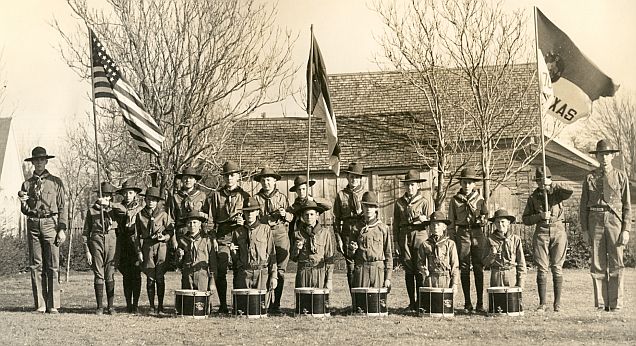 Dublin had an active Drum and
Bugle Corp in 1938. Led by W. E. Sparks, they put on a demonstration
at the Annual Boy Scout meeting held in Brownwood on January 21, 1938,
and again on January 27, 1939. In April, they led a Scout parade
and gave demonstrations of their skills in that community. On June
15, they went to Fort Worth and participated in a parade in connection
with the State Safety Meet. The corp was made up of Scouts from Troop
22 and Troop 24.
Dublin had an active Drum and
Bugle Corp in 1938. Led by W. E. Sparks, they put on a demonstration
at the Annual Boy Scout meeting held in Brownwood on January 21, 1938,
and again on January 27, 1939. In April, they led a Scout parade
and gave demonstrations of their skills in that community. On June
15, they went to Fort Worth and participated in a parade in connection
with the State Safety Meet. The corp was made up of Scouts from Troop
22 and Troop 24.
The Drum and Bugle Corp performed
at the Council Rally held on September 2, 1938, at Lake Eanes, Comanche,
with some one hundred and fifty Scouts present. Scouts attended the
Rally from Dublin, Comanche, Gorman, Rising Star, Brownwood, Mullin, Zephyr
and San Saba.
Later that year, in September,
they returned from participating in the American Legion Convention parade
in Austin and were greeted by “a small army of automobiles containing local
citizens who immediately got into parade form and rode down the city streets
headed by the Drum and Bugle Corp.”
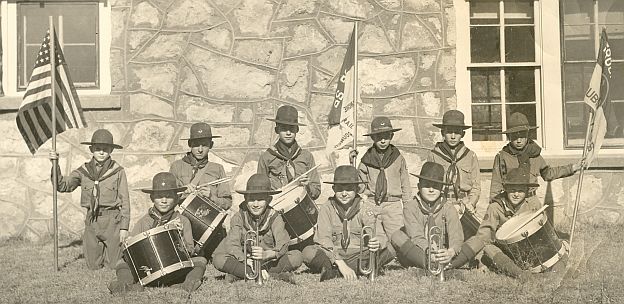
There is also a photo of a Drum
and Bugle Corp that existed in San Saba from Troop 55. No date as
to when the photo was taken.
Band
In Brownwood?
We think there may have been
a Boy Scout band in Brownwood in the spring of 1931. A brief story
in the “Boy Scout News” section of the May 16, 1931 Brownwood Bulletin
stated that “Merle Baker, Boy Scout Band director, made a report on the
progress of the band.” However, nothing was ever reported about
any activities of the band in the community.
Added: June 3, 2011
Home |


 Troops
17 and 18 of Breckenridge arrived at Camp Billy Gibbons in 1932 with a
“well organized band” according to a story in The Bugle Call, the camp
newspaper. The band played “Onward Christian Soldier” while three
Eagle Scouts carried a floral wreath and placed it on rocks gathered by
Scout Troops to use in building a memorial to Billy Gibbons on Sunday,
July 24, 1932.
Troops
17 and 18 of Breckenridge arrived at Camp Billy Gibbons in 1932 with a
“well organized band” according to a story in The Bugle Call, the camp
newspaper. The band played “Onward Christian Soldier” while three
Eagle Scouts carried a floral wreath and placed it on rocks gathered by
Scout Troops to use in building a memorial to Billy Gibbons on Sunday,
July 24, 1932.

